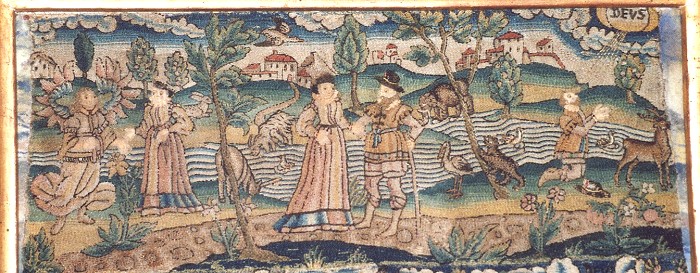
Announcement of Samson's birth
| ANNE WANNER'S Textiles in History / publications |
|
| I
am going to talk about a group of wool embroideries from
eastern part of Switzerland which were popular from about
1520 until the Thirty years’ war in 1618 until 1648. Coat of arms of Swiss families, Initials or Dates which sometimes appear on the pieces, are helping to classify them. These and other textiles for indoor furnishing show the more pretentious stile of life in the 16th and 17th c. after the troubles of reformation and counter reformation. We should also consider the following facts: - trading companies were selling their goods all over Europe. There was a Company also in St.Gallen in Switzerland. It traded with linen from Spain to Poland. Raw cotton material was carried over the Alps from Italy. Silk materials was brought from Italy by Italian religious refugees. - with new goods also new and special techniques arrived in Switzerland - Painters after Reformation were having a hard time, because the church no longer was their best employer. They were looking for new customers. It is well imaginable that rich citizens ordered designs in artist’s workshops. |
The disposition of my lecture is
the following: |
|
| The
story of Samson begins with the announcement of his
birth. An angel appears to the wife of Manoah, who so far
had remained childless. The angel tells her that she will have a son. He instructs her not to drink wine or other fermented drinks and not to eat anything unclean. After the son’s birth, no razor may be used in his head. The reason is that her son will be set apart to God from birth and he will begin the deliverance of Israel from the hands of the Philistines. |
Manoah
the husband does not believe this and he begs to god to
send him another sign. All this happens in front of a landscape with hills, mountains, trees, houses. Much care is given in representing the river and the water. On its border there are many different animals: there is even an elephant, a bear, birds. The close ups show how the borders were cut and restored by painting. |
|
| In
the second scene Maonah’s request
was accepted, the angel reappears and repeats what he had
said before. Again the persons are acting before a lovely landscape with birds and animals. Also note the interesting shape of the clouds, which look like plaited hair. |
Very
special also are the small borders with many different
flowers and fruit. Interesting shape of the clouds, which
look like plaited hair. Very special also are the small
borders with many different flowers and fruit. |
|
| In
the third stripe Samson, now grown up, figths the
lion. The bible says that the spirit of the lord came
upon him in power so |
that
he tore the lion apart with his bare hands as he might
have torn a young goat. |
|
| Samson
was in love with Delilah and this woman found out
the reason for his strength. When Samson was asleep, she
cut off |
his
hair and the soldiers were now able to bind him. They put
out his eyes and arrested him. |
|
| The
last scene, shows the destruction of the temple.
As Samsons hair began to grow again his strength came
back. One day, when the Philistines came together to
offer a sacrifice to their god, they called for Samson.
They wanted to amuse themselves by his blindness. Samson
prayed to god: O God, please strengthen me just once
more, and let me with one blow get revenge on the
Philistines for my two eyes." Then he reached toward the two central pillars on which the temple stood. Bracing himself against them, his right hand on |
the
one and his left hand on the other, Samson said,
"Let me die with the Philistines!" Then he
pushed with all his might, and down came the temple on
the rulers and all the people in it. So the temple fell
upon all the people that were therein. It is a terrible story, but in spite of this catastrophe the landscape remains peaceful. We find all the elements noted on the other scenes: The hills, and mountains with houses, birds, animals. |
| A
private collector acquired this embroidery in 2002 from
art trade. It shows events in the life of Samson,
as they were described in the Old Testament, in the book
of the Judges, in chapter 13. The embroidery is now presented in a wooden frame, with 5 stripes joined to one another, but this is not its original use. The stripes measure about 18 cm by 45 cm each, and the framed picture measures about 100 x 45 cm. No inscriptions, no initials or coat of arms can be found. The ground fabric is unbleached linen which is totally covered with coloured woolen yarns. Some painted additions can be seen at the ends. This was probably done at the occasion of framing the piece. The endings of the single stripes or picture-scenes do not fit to one another. And we are not sure whether some parts of the embroidery are missing. It is also uncertain whether it was originally a long picture frieze or whether the stripes were used in another combination. |
Materials, technique: |
| The
stories of the Old Testament were very often represented
at this time. There is another wool embroldery in the
Swiss National Museum in Zürich which is decicated
to the same subject. Here we can find the date of 1608 and the Initials E.Z. It comes of the eastern part of Switzerland. The coat or arms of the Zollikofer and Schlapprizi families point to this origin. It measures 38 x 50 cm. The side borders are 17 cm wide and 39 cm long. |
Like
the first embroidery also this one was worked on
unbleached linen ground and it is embroidered with
coloured wool yarns. The technique is the same kind of
couching work, the fabric being totally covered with
stitches. The museum’s records consider this piece
to be a chair cover. I have some difficulties in believing this. What would be the appearance of a chair, covered with this embroidery? Why are the corners of the front piece rounded? Also are the colours of the embroidery very bright and no traces of everyday use can be found. Wasn’t it rather intended to cover a lid of some kind of a casket or box? |
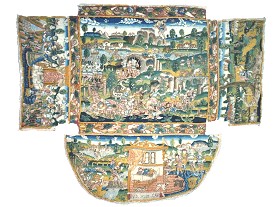 |
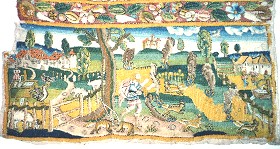 The story of Samson on a chair cover in the collection of the National Museum in Zurich |
| On
the piece, some other scenes of the Samson story are
represented: - here we see his wedding to a Philistine woman, - Samson put a question to his guest, and this was a riddle. He got very angry, when his wife told the solution to the Philistine guest, and in this way the war against the Philistines started. Let us have a look at the center scene. It shows the battle scene of Samson with the Philistines. The persons also in this piece are acting before a landscape which is similar to the one we saw before. There are also many animals and in the sky the same plaited clouds can be observed. Quite interesting, there is even the small border with fruit and leaves between the bars. |
The
2 pictures belong to the Samson story, the one on the
left is from private collection, the above right detail
from Zürich. The two are very similar to each other. Techniques and materials are equale, the measurements almost the same and a correlation in stilistic details can be found. It is therefore possible to conclude that both were worked around the same time. The piece in Zürich bears the date of 1608 and we can therefore date the Samson embroidery private around 1600. A third detail is slightly different. It belongs to the story of Tobias, which I am going to show next. Please note: it is worked on a black wool fabric, this ground fabric is part of the composition. |
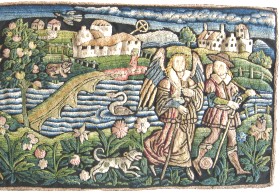 |
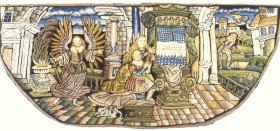 2 scenes of the Story of Tobit, Textilmuseum, St.Gallen |
| The
story of Tobias. The embroideresses Another series of embroideries with stories of the Old Testament is preserved in the Textile Museum in St.Gallen, in Switzerland. The story of father and son Tobias is represented. There are no coat of arms, no dates, no initials But there are again 6 rather small stripes in different sizes. Most of them are about 20 cm wide and up to 60 cm long. There is no bigger rectangular piece preserved, an if we consider the series to have been used as a chair cover, maybe a bigger piece has existed and it has been destroyed by using the chair. As in the Zurich Samson embroidery, here too we find one of the stripes with rounded corners. So also in this case the series probably did not belong to a chair cover. Also in this case we do not known the original use of the piece. |
The
content of the story: The Book of Tobit (or Book of Tobias) is regarded as an apocryphal text, which means that these texts are of uncertain authenticity and they fall outside the canon. Nevertheless the story of Tobias was well known and very popular in the 17th c. The book of Tobit is often quoted because it shows the intercession of angels, reverence for the dead and filial piety. This subject is also found in tapestry weave, in paintings, in graphic illustrations. Tobit the father was particularly noted for his diligence in attempting to provide proper burials for fallen Jews. One night he buried a dead man who had been murdered on the street. That night, he slept in the open and was blinded by bird droppings that fell in his eyes. |
| The
main narrative is dedicated to Tobit's son, Tobiah or
Tobias, who is sent by his father to collect a sum of
money. Under the guidance of the angel Raphael, Tobias makes the journey and along the way, he is attacked by a giant fish, whose heart, liver and gall bladder are removed to make medicines. Raphael tells Tobias of the beautiful Sarah, whom Tobias has the right to marry, because she is related to his tribe. But Sarah has already lost seven husbands to a demon who kills every man she marries on their wedding night. |
Tobias
sends Raphael to recover his father’s money. Raphael now instructs the young man to burn the fish's liver and heart to drive away the demon when he attacks on the wedding night. The two are married, and the fumes of the burning organs drive the demon away while Raphael follows him and binds him. After the wedding feast, Tobias and Sarah return home to father Tobit. There, Raphael tells the youth to use the fish's gall to cure his father's blindness. Raphael then reveals his true identity and returns to heaven. |
| Tobias in the Swiss
National Museum and the question of the embroideresses. |
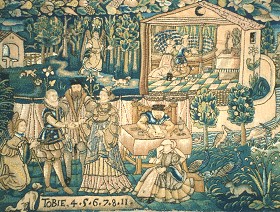 |
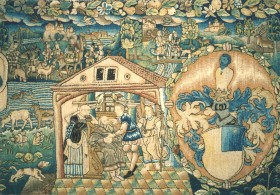 2 Scenes of the story of Tobit in the National Museum Zurich, Switzerland |
| I
am now going to show you a wool embroidery from the Swiss
National Museum who is also dedicated to the story of
Tobias, there is the date of 1601 and the Initials
BP, which point to a Barbara Peyer as creator. The coat
of arms are those of the Peyer and Zollikofer families of
Schaffhausen, situated in northern Switzerland. Here we
have an embroidery in one piece. It is 36 cm wide and 174
cm long. The ground fabric here is again unbleached
linen. Although at first sight this embroidery looks similar to the other examples shown here, there are some differences. The scenery is wider and the motives, especially the main buildings are shown on different levels. A comparison with details shows that clouds are looking differently and also the border with fruit and leaves shows another more three dimensional way of formation. In the time before 20th century embroideresses usually did not design their motives themselves. They were concentrated on the technical part, on needle and thread. The bible was often used as a source for the content. This epoch did not have any copyright problems and it was customary to copy forms and shapes. Any printed or painted illustration of the time could serve as model. Illustrations of the bible, also models in pattern books can be traced in all the crafts of the time. Augsburg and Nurnberg were centres of book printing. The earliest pattern book was published by Johann Schonsperger in Augsburg in 1523 and the most widespread by Johannes Sibmacher was printed in Nuremberg in 1597 and 1601. |
Very
little is known about the embroideresses of these
works of art. Some authors came to the conclusion
that the daughters of citizens, occupied with their
trousseau, created these neeedle works. - A tapestry dated 1601 from the Swiss National Museum in Zürich with portraits of the Morelli family is often quoted in this context. It seems that a Luigia Morelli probably was the embroideress, as her name appears as an inscription around her portrait. More proofs can be found in some letters of the time. So the reformer Ambrosius Blarer from Constance was writing to Heinrich Bullinger (1504-1575), the main parson in Zurich, among other topics he also wanted his niece Petronella to be introduced into the art of embroidering. The Bullinger daughters were famous for this artistic skill. Jenny Schneider, former curator of textiles in the Swiss National Museum researched about the question of embroideresses. She found several embroideries signed with the initials BP. With the help of coat of arms she traced a Barbara Peyer from Schaffhausen who created many beautiful wool embroideries. She lived from 1549 until 1613 and married Hans Im Thurn who later became mayor of the city of Schaffhausen. |
Comparison with a Munich table carpet. Models and pattern |
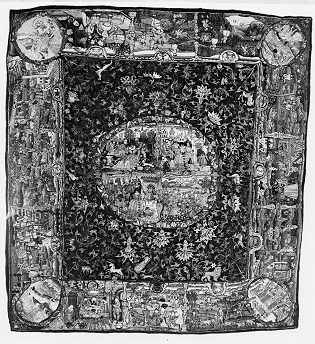 |
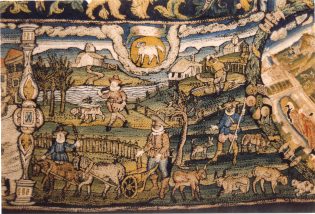 Table Carpet and Detail of the border, Munich |
| Sabine
Philipp was recently studying wool embroideries in
her master thesis in art history. And she pays much
attention to the place of origin and to the
embroideresses. The main piece of her interest was an embroidered table carpet in Bayerisches Nationalmuseum in Munich. This table carpet in Munich measures about 2 x 3 meters. Sabine Philipp compared the table carpet with the Swiss wool embroideries: Like the Tobias embroidery of St.Gallen it is worked on a dark woolen ground fabric. And like the Samson embroideries we see similar small borders, about 20 cm wide. In the center there are representation of the Old Testament: it is Susanna and the Elders. Around these scenes phantastic blossoms and tendrils, and in between domestic and wild animals are represented. In one corner the coat of arms of the Pfister family of Lindau near Constance can be found. |
I
want to draw your attention espescially to the border
part of the tapestry. Here seasonal labors together with
the Zodiac signs are represented. There also is a
landscape which is very similar to the other embroidered
examples here treated. Sabine Philipps comparing the Tobias in St.Gallen with the Munich piece comes to the conclusion, that the St. Gallen Tobias is very close to the Munich embroidery. Both were embroidered in the same place, but not by Barbara Peyer, as the Tobias embroidery in Zurich. Her studies further show that there must have been a kind of a workshop in the region of the lake of Constance. |
| In
this place I am going to present some thoughts regarding the
question of representing landscape in the 16th
and 17th c. I will make a
short excursus into the the field of a painting. I am presenting to you one of the 4 oil paintings representing the labours of the months. They were made in 1531 for a rich family from Augsburg, maybe the Rehlinger family. Each of the 4 picture measures about 2 x 3 meters. After being for years in private possession, they are now preserved in the Berlin historic museum. |
These
paintings have been intensely studied. I believe that
these studies are useful regarding the question of
models. And I further suppose, that it was possible to
use the same models for different crafts. Labours of the months or seasonal pictures are known since medieval times, and in the 16th c. a development of landscape painting for its own sake is to be observed. Interesting enough the models for these paintings can be found in stained glass windows. The relation to the craft of stained glass is obvious. |
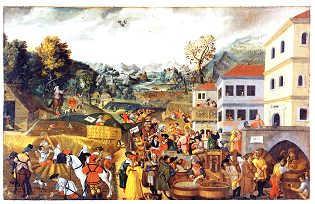 Oilpainting, with labours of the month, today Berlin, Germany |
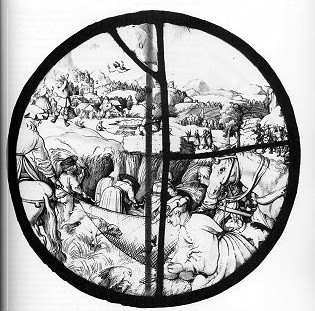 Glaspainting, today Kaiserslautern, Germany by Jörg Breu the older, 1480-1537 |
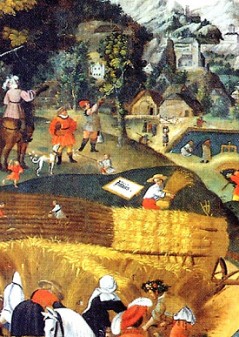 Detail of Oilpainting, Berlin, Germany |
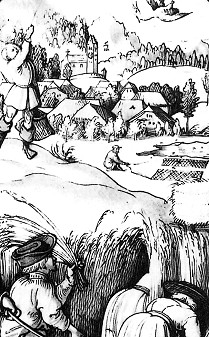 Detail of Glaspainting, today Kaiserslautern, Germany |
| By
the 1600s a style of stained glass had evolved that
was no longer dependent upon the skilful cutting of
coloured glass into sections. Scenes were painted onto
glass panels, the colours were annealed to the glass and
the pieces were assembled into metal frames. Citizens
used to adorn the windows of their houses with this kind
of art work. Very fashionable were heraldic scenes. In 1525 the artist Jörg Breu the Elder (1475-1537) made drawings for stained glass, and it is quite obvious that the same models also served for the painting with the labours of the months. The works of Jörg Breu the Elder are among the earliest works of the Danube School and they reflect an innovative interest in nature’s moods and in depicting landscape for its own sake. Below you see a close up of the seasonal paintings, compared to close ups of the wool embroideries. Looking at the paintings, it can be noted that - The representation of landscape is of special interest. It was in the 16th c. when artists began to treat landscape as an own subject. Preliminary stages can be traced in the pictures, which represent seasonal labours. From the beginning of this lecture I pointed to the landscapes as shown in the embroideries. The question arises - were the embroideries inspired maybe by paintings of the time directly? - Is is also possible that the artist made paintings used as models for minor arts and crafts like stained glass windows and for embroideries as well? |
It
seems that in workshops for stained glass three
different kinds of design existed: - there was a painting or a drawing of a professional artist, which must have been kept as a master drawing and preserved for further use. - the same artist, possibly also another artist, would then produce a workshop drawing, which served for the commission in question - the designs outline were traced on the glas with a marker, or a special outline desing was put under the glass as a working model. It is known, that in a workshop of stained glass in 16th and 17th c. a great number of drawings were used and they must have had a big supply in design of this kind. Is it possible that embroideresses used the same stocks? In both cases rich citizens were the customers, they used to adorne their houses with heraldic scenes in glass and with wool embroideries sometimes showing coat of arms and heraldic scenes as well. As for the artists: in the time of reformation many of them had commissions of the church and they looking for for customers. The rich citizens of the period until the 30 Years’ war, were adequate customers. |
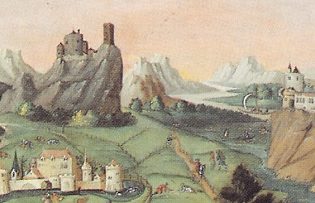 Detail of Oilpainting, Seasons, Berlin |
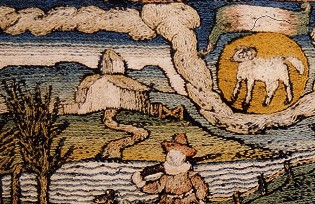 Detail of Table Carpet, Munich |
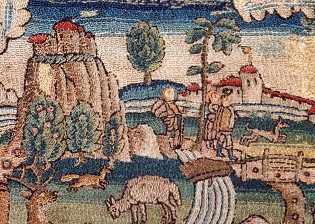 Two Details of Samson, private collection |
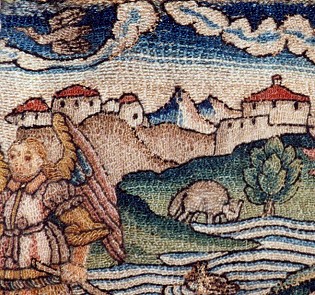 |
| Wool
embroideries with tendrils, animals. Conclusion When I reached this point of my studies, I found it important to travel again to the Flaach Castle in Switzerland, to study once more the Samson embroidery in the private collection. The collector lives in this small castle, which is furnished in the style of 17th and 18th c. There I walked across some rooms and I discovered a canopy bed decorated with a wool embroidered valance. This embroidery had drawn my attention earlier. I had noted it in a book published in 1919, in a corpus of plates, dealing with the former Iklé collection. But it was reproduced here in a very different shape. This former Iklé embroidery had been acquired a couple of years ago by the private collector who also owns the Samson embroidery. There were 5 stripes joined together and luckily, the endings of these stripes were fitting to each other. A textile restorer took the the pieces apart and assembled them to what he believed to be its original valance aspect. |
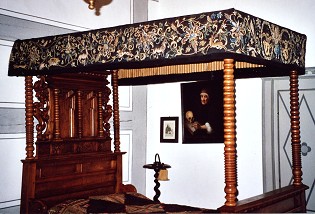 Bed Valance, recently set up |
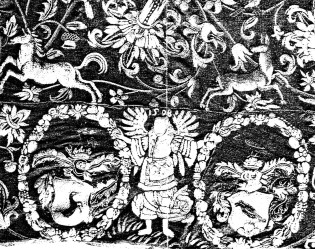 Detail of bed Valance as published in Ikle/Faeh, 1919 |
 Two Details of Bed Valance, private collection |
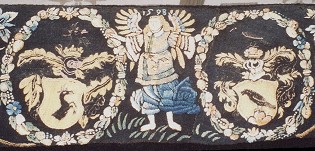 |
| This
valance is about 27 cm wide and almost 5 m long. The
embroidery is applied to a dark woolen fabric and does
not cover it completely. So the ground fabric is part of
the composition. There are the coat of arms of the Schobinger and von Rudolfis families and the date of 1598. - compared to the already presented table carpet in Munich, we see similarities to the inner parts of the carpet with its tendrils and animals. - Correlation is also found with the small borders with leaves and fruit which decorated both Samson stories embroideries with the story of Samson. |
But
while these examples had been embroidered on unbleached
linen, the valance is on dark wool. Does this mean that
ground fabrics in linen and in wool were used by the same
embroideresses? It is hard to answer this question as we
still do not have enough evidence. Sabine Philipp, the art historian already quoted, found close relations between the Tobias story in St.Gallen and the Munich table carpet. Important among other feature in her eyes was the correspondance of the ground fabric. And she too had the opinion that further studies on the material used in the workshops of the time should be necessary. |
 Detail of Border, Samson, private collection |
 Detail of Border, Samson, Zurich |
 Detail of Border, Bed Valance, private collection |
 Detail of Border, Tobias, Zurich |
| I
am going to conclude this paper with an embroidery
dated 1624. This cushion on a dark woolen ground fabric is today in the Swiss National Museum of Zurich. It bears the Initials E.Z. and the coat of arms of the Zollikofer and Spindler family. The measurements are 45 x 56 cm. At first I want to show that also in later years there pleasure in representing animals in phantastic tendrils still can be found. It is obvious that similar or even the same models have been in use over a long period of time. Almost the same shapes appear for 50 and more years. So far it was not possible to find out whether needlewomen worked in private houses or in workshops. They were crafts and needle women and at this time did not create from their own ideas.They were using popular models and design of the region. |
In
the 16th and 17th centuries angels
were often represented. They were present in almost every
piece we have seen today. Men of late medieval times
wanted to emphasize the fact that it is God to
direct the fate of mankind and he will bring everything
to a good end. This message was communicated through the
Old Testament. And it is specially the book of Tobit to
show the intercession of angels. Slight differences in style can be found but from the early representation up to the later ones, from simple to better embroidery quality there is a similar conception. So also here we note that models must have been available and used over many years and all over in this region of the center of Europe. And as long as there are no documents or evidence of ateliers, it will be hard if not impossible to find the names of needlewomen or to locate workshops. |
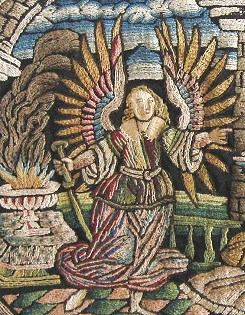 Angel, detail Tobias, St.Gallen |
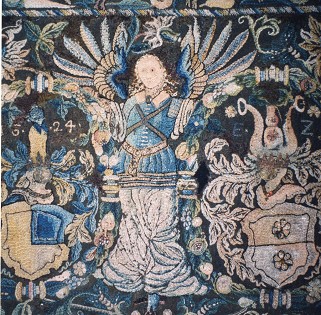 Angel, detail Cushion Cover, 1624, Zurich |
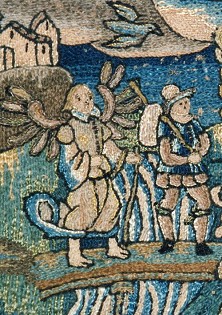 Angel, detail Tobias, Zurich |
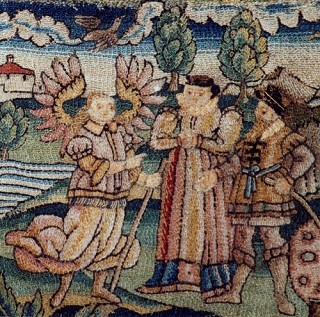 Angel, detail Samson, private collection |
| content | Last revised 24 November 2011 |